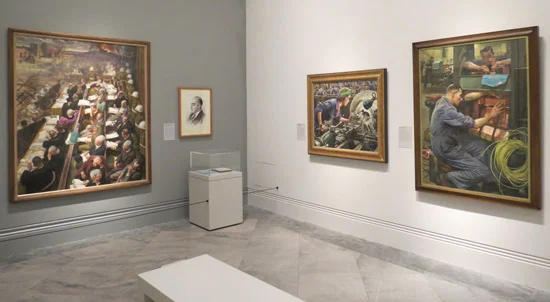 |
| Battle of Britain by Paul Nash An abstracted aerial view of a wide flat landscape including the mouth of a river. Above the sky is full of aircraft contrails and smoke plumes, while to the upper right aircraft are flying in formation |
Alastair Sooke explores the often overlooked history of the wartime art boom, meetingBlitz survivors, factory workers and Land Girls who became the subject of paintings, talks to contemporary artists about the challenges of creating work in conflict zones and considers how the images produced during the `People's War' laid the groundwork for a modern understanding of what art should be.It reminded me of some of the exhibitions at the time of the 60th anniversary of the start of World War Two.
 |
| Portraits by Dame Laura Knight |
I highly recommend a viewing of the programme. It was very good - particularly in relation to:
- the role played by Kenneth Clarke, the Director of the National Gallery played in relation to:
- moving the National Gallery collection to a disused slate mine near Blaenau Ffestiniog in north Wales
- setting up and chairing the War Artists' Advisory Committee,
- persuading the government to employ official war artists in considerable numbers.
- buying artwork produced by soldiers
- he ended up with 6,000 works of art which were displayed around the UK at the end of the war
- the emphasis on the art being about the war and reaching out to and engaging with people
- insight into the approach and practices of various of the war artists - using those who had witnessed working at the time
War Artists on full-time salaried contracts
- Edward Ardizzone
- Edward Bawden
- Muirhead Bone
- Stephen Bone
- Henry Carr
- William Coldstream
- Leslie Cole
- Charles Cundall
- William Dring
- Evelyn Dunbar
- Richard Eurich
- Reginald Grenville Eves
- Barnett Freedman
- Anthony Gross
- Bernard Hailstone
- Keith Henderson
- Thomas Hennell
- Eric Kennington
- Henry Lamb
- Thomas Monnington
- James Morris
- Rodrigo Moynihan
- John Nash
- Paul Nash
- Mervyn Peake
- John Piper
- Roland Vivian Pitchforth
- John Platt
- Eric Ravilious
- Albert Richards
- Leonard Rosoman
- Rupert Shephard
- Graham Sutherland
- Alfred Thomson
- Carel Weight
- Charles Wheeler
- John Worsley
 |
| Dame Laura Knight - War Artist (left to right) The Dock at Nuremberg, charcoal study of the British prosecutor David Maxwell Fyfe Ruby Loftus screwing a breech ring and Switch Works© The Estate of Dame Laura Knight DBE RA, 2013 |
In May 1940 WAAC sent Spencer to the Lithgows Shipyard in Port Glasgow on the River Clyde to depict the civilians at work there. Spencer became fascinated by what he saw and sent WAAC proposals for a scheme involving up to sixty-four canvases displayed on all four sides of a room.[38] WAAC agreed to a more modest series of up to eleven canvases, some of which would be up to six metres long. Wikipedia - Stanley Spencer
 |
| Totes Meer (Dead Sea) 1940-1 Paul Nash 1889-1946 Tate Britain Presented by the War Artists Advisory Committee 1946 |
